A Simple Guide to Understanding Tech Support Jargon
If you’ve attended a meeting before with an outsourced tech support agency or with professionals in the industry, then you’ve probably encountered someone blurting out tech terms incomprehensible to others outside the field. During these situations, someone almost always ends up saying, “In English, please.”

This familiar image rings true to customers talking to tech support specialists and support specialists working with anyone outside their department. It’s like a conversation with two people speaking in two different languages.
It can be quite overwhelming for people who aren’t technologically well-versed to explain a complicated issue to a specialist. In the same way, it can be difficult for experts to find and offer solutions if that person is unable to communicate the problem clearly. The future success of technical support depends on how well your team is able to overcome these "language barriers".
Get in the Know With the Technobabble
To anyone but a tech specialist, jargon and error messages may appear like just a hunk of gibberish. As an IT worker, business owner, or professional in a technical industry, it’s your responsibility to familiarize yourself with these terms in case you encounter them. More importantly, ”talking the talk” will help in keeping a smooth flow of communication between you and your outsourced tech support team, allowing you to build a more productive working relationship with them.
What you need is a glossary of no-fuss, snackable definitions of technical jargon to wrap your head around unfamiliar terms quickly. To help you bridge the language gap, here are 40 tech terms broken down for everyone’s understanding. It’s time to crack the code!

Tips to Ensure Your Tech Support Conversation Goes Smoothly
Communication is a give-and-take process—working with a tech support specialist is exclusively about that. When you encounter an issue way beyond your knowledge and control, there goes your tech team to the rescue. You have to work together to make the job a little less complicated to resolve the issue as quickly as possible.
Here are ways to make your conversation with your outsourced tech support specialist a more pleasant and less painful experience.
Be Prepared Before Making the Call
Before you ring them up or message them about your concern, make sure that you know what to say. The more prepared you are to explain the details, the less time you’ll have to spend going round and round about the problem. Here are a few things to observe before you pick up the phone:
Timeline: When did the issue turn up? How long has it been occurring since?
Troubleshooting: Have you tried fixing the problem yourself before? Whether it made the problem worse or held it off for awhile, you need to let your tech staff know if you’ve done anything already.
Error message: For instance, System Error Codes, Browser Error Codes, Blue Screen of Death (BSoD)
If there are no error messages, write down exactly what’s going on (e.g., screen freezes every time you open a specific application). Saying “it just stopped working” won’t help.
Write these down before you call for help. Not only will this help your tech support better understand the issue, but it’ll give then more time and possibly less effort to find a solution.
Explain the Problem Clearly
When it’s time to report the problem, you can’t just point to the screen and shrug your shoulders implying you have no idea what happened. You need to give them more than “the internet doesn’t work.”
Vague: “The internet stopped working.”
Clear: “Chrome stopped working, but Firefox works fine.”
Explain in full detail what you did before and after the issue arose. Don’t hold back any information. You wouldn’t know which are irrelevant and which aren’t, so telling them as much detail as possible can help speed up the process.
Follow the Instructions
Before you ask “are you sure this will work?” Test it out first. Make sure that you follow all the steps.
If your tech support asks you to check something, you need to follow the instructions to the letter. Even if you’ve tested it before and found nothing, do as they say—they know what they’re on to. There’s a reason why they’re walking you through this, so it’s crucial that you follow their lead. If you don’t understand the instruction, don’t be afraid to ask.
Repeat the Details
One way to prevent miscommunication is by repeating after what they say. For example:
Support specialist: “Go to menu A, look for X then click Y, then select Z.”
You: “Okay, I found menu A, I clicked on X, then I clicked y, and then z.”
Doesn’t this sound clearer than “Okay, done”? Repeating what they’re saying as you go through the steps—being more specific—both of you will feel confident that you’ve completed the instruction. This proves that you understood each other.
Ask for a Ticket Number
Also called a reference number or incidence number, a ticket number refers to your tech support’s ticket management system which records the problems they receive.
They are required to track the details of your call in the reference number so if another specialist has to take over, he or she can pick up from where you left off. This especially helps if you need to call again.
TL; DR
Don’t let the language barrier become this huge, thick wall between you and your tech staff. You’ll misinterpret some techy terms, but don’t worry. This just means you have to be more patient and mindful of the gap—and find ways on how you can both meet halfway. Brushing up your knowledge on some technobabble and avoiding costly tech support mistakes is a good start.
Support specialists are always happy to help and solve mysteries. Having an excellent outsourced tech support in your team to walk you and your customers through any technology crisis can help you get back to work in no time, keeping your business operations running ever so smoothly.
The tech support world can be difficult to navigate without the right support staff. Find out how the experts at Intelligent Bee can help improve your business today!
9 Examples of Businesses Creating Awesome Mobile Apps
Businesses that venture into the mobile app industry have better chances of interacting with users of their product or service straight on their smartphone. It’s an effective way of engaging consumers, especially since it’s said that an average smartphone user has more or less 17 to 18 apps installed on their phone. Hours spent among smartphone users are also leaning heavily toward app usage, with 90% of time spent in-app.

Indeed, trends state that corporate mobile apps can help companies achieve their objectives – whether that involves building a base of loyal users or finding an extra source of revenue for the company. With multiple ways of monetizing their apps such as download fees, subscription, in-app purchases, advertising, more companies are willing to invest their time and resources in building mobile apps that can establish their brands as industry leaders.
Mobile Apps by Businesses That Set the Standard for Awesome
Here are some of the best examples of corporate mobile apps out there, courtesy of companies that are dead serious about bringing their business on mobile and innovating the way of doing things for customers:
Amazon
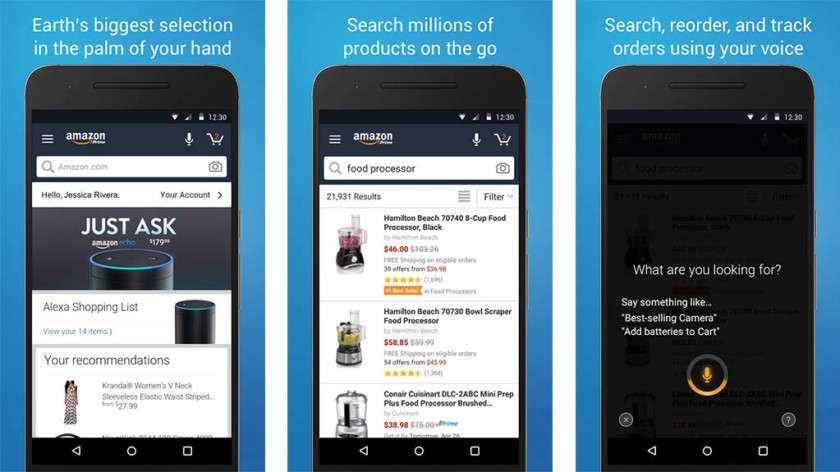
Amazon has become a household name, and its mobile app has a great deal to do with the status it has established. As the leader in America’s online retail industry, Amazon raises the bar with the way its app works for customers as well as for its own business.
The app’s push notifications are very useful for customers, who instantly get alerts when Amazon starts shipping their orders. Customers don’t have to keep checking their account to know the progress of their expected deliveries. This kind of awareness reduces the anxiety and frustration that customers feel before receiving their parcels, not to mention that Amazon’s brand name stays on top of customers’ mind.
To initiate sales, the Amazon app also comes with a wish list feature. Amazon users can share their wish list on their social media pages for their family and friends to see, increasing the chance for Amazon to make a sale.
Domino’s Pizza

In the case of Domino’s Pizza, the company similarly uses tracking technologies to inform customers about the status of their pizza order – whether it’s on the preparation stage or in the process of delivery. Not only that, as customers can use the app to create tailored takeaway meals from Domino’s standard menu. It’s a perfect example of delivering a personalized experience based on the actual preferences of customers.
easyJet

EasyJet is a British airline that enables travelers to manage their flights directly on its app. The easyJet mobile app serves as a one-stop travel shop where passengers can search for and buy tickets for domestic and international destinations. The app also allows adding of seats, online check-in, and downloading of boarding passes, making every transaction as convenient and as worry-free as possible.
easyJet customers can also track the arrival and departure for all flights and even get live updates from the airline’s Control Centre. Beyond these functionalities, the carrier’s mobile app is hailed for reliability, accuracy, and timeliness of service.
iFood Assistant by Kraft

iFood Assistant is Kraft’s corporate mobile app that offers a wealth of dish recipes based on Kraft food products. Users who want to cook up a particular dish can easily create a shopping list within the app, paving way for Kraft to suggest using ingredients that are manufactured by the company. What’s even better about the iFood Assistant app is that it offers coupons that users can use for groceries or other promotions from Kraft.
L’Oreal Makeup Genius

Cosmetics company L’Oreal ventured into the augmented reality (AR) space to give customers a chance to try out its products through the Makeup Genius app in 2014.
Using advanced facial mapping technology, the app allows users to virtually apply makeup on their face and turns the users’ smartphone camera into a virtual mirror, allowing them to see the results of their makeup session in real time. This makes product testing a lot more convenient and enhances the customer experience as a whole.
To make this happen, Makeup Genius scans the users’ face, chooses suitable L’Oreal products, and applies them virtually on the users’ eyes, lips, and other facial contours. The app is smart enough to follow the head movements of users, so they can see how the makeup looks on them from various angles.
MLB.com

Baseball fans will never miss out on what’s happening in the sport league, thanks to the MLB At Bat mobile app. The app allows users to watch and listen to the games in real time. Users can also check the app’s archives and follow their favorite team as the app shares the latest news, game standings, and other stats. The app caters to Android, BlackBerry, and iPhone users with the same functionalities across platforms.
Midland Medical

Businesses that regularly perform stock inventories can follow Midland Medical’s lead in tapping digital technologies to its processes. As a distributor of medical supplies, Midland Medical needed to speed up its inventory receiving process, so it could respond to customers’ queries with just a quick look at its database.
To achieve this goal, the company took advantage of readily available tools, such as mobile devices and Bluetooth scanners, and went a step further in mobile app development by going for a custom-built software application that enables warehouse personnel to automate the addition of new inventory into the company’s database. In addition, they opened up the customer side of things
MY ASICS

Corporate mobile apps can also be a way for companies to interact with the communities they’re serving. ASICS, an equipment and apparel company, does this by offering customized training plans and helpful content that users can take advantage of on the MY ASICS app. In turn, ASICS receives valuable insights and feedback about the kind of products or services that fitness enthusiasts want.
thetrainline

The thetrainline mobile app is for users who prefer to book train tickets in advance. Once they have a confirmed booking on the app, they can just pick up their tickets across UK train stations. The app also gives users a chance to find the best fares and save their favorite journeys to make it easy for them to book their next trip.
On the business end of things, the app also shortens the time it takes to buy a ticket. The reduction in transaction times for train companies simply means more efficiency and more savings in the long run.
Wrap-up
There’s not a doubt that the business landscape looks bright for companies who are venturing into mobile app development. Mobile apps can help enterprises capture a significant share of one of the fastest growing segments in the global economy.
If you haven’t ventured into the mobile app industry, it may be time to do so. You don’t have to focus on the selling aspect through and through, when you can be creative enough to incorporate information about your products or services through other features of your app.
Moreover, you should be ready to experience some challenges along the way—such as finding the right mobile app development company. Just make sure your mobile app development partner truly understands your business model and designs the app accordingly so your company will run more efficiently.
Want some help developing your next mobile app? Contact the team of experts at Intelligent Bee today!
10 Brilliant Examples of Tech Support Gone Wrong
Most businesses these days rely on stable internet connections and complex computer systems to handle their daily operations. So when something goes haywire in your network or device, who you gonna call?
Your amazing tech support team (nope, not the Ghostbusters)!

These trained professionals are your front liners against a multitude of issues. From network connectivity problems to DDoS attacks, your tech specialists can help you get back to work in no time and safeguard your business’ best interests.
But sometimes, conversations with your tech support team don’t go the way you expect it to. The same narrative happens when support reps chat with customers. This can be frustrating since it can create inefficiencies within the company that incur additional costs.
When Tech Support Goes Wrong
Tech support professionals are people, too, and they make mistakes just like any regular joe. Problems arise, and things go wrong—that’s part of the business. But there are ways to prevent and correct these mishaps. Take a look at these chat support blunders and see how each one should have been resolved.
Over-automated responses
Canned responses make operations easier for businesses and assure customers that their inquiry is acknowledged. But it doesn’t resolve customer problems right away. Customers want personal conversations. Automated responses just won’t cut it.
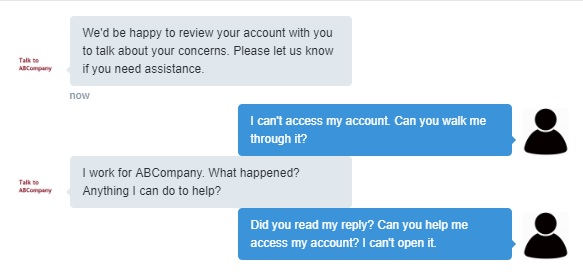
Solution: Using chatbots is more common nowadays, but it would have been more effective if the bot redirected the customer to a real person after the initial greeting. This would’ve solved the problem faster and given the customer a smooth experience.
Failing to inform customers you need time to resolve their issue
Tech support specialists aren’t always available to address a problem right away. Maybe they’re on break or dealing with internal tasks. But this shouldn’t be an excuse to leave your customer hanging.
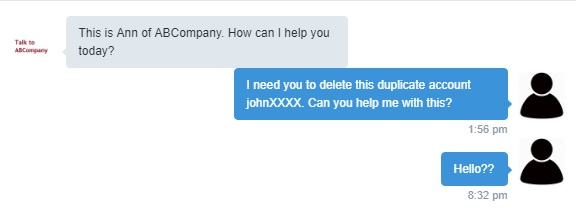
Solution: If the tech support needs time to look into the issue, a response like “I need a few moments to resolve this issue. Do you mind holding on while I look into it? Really sorry for this inconvenience, [customer’s name]!” You can also ask the customer to leave their contact information followed by: “If you’re in a hurry, I’d be more than willing to email you with an answer.”
Not letting go of customers
It’s sad to see your customers go. But when they’ve made the firm decision to end the contract or unsubscribe from your services, the best approach would be to provide them a great service until the very end. Below you’ll see a clingy representative who refuses to give up on the customer.
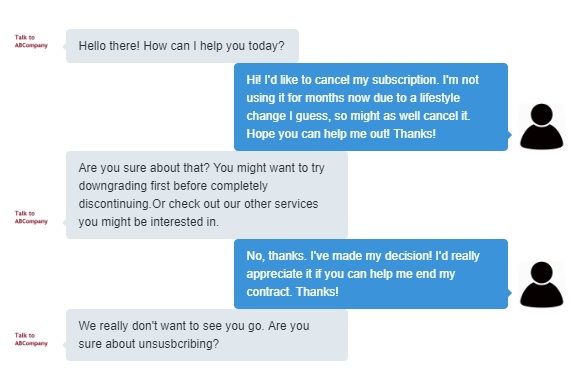
Solution: When a customer decides to discontinue their relationship with your company, it’s best to give them what they want. You’d want to keep the conversation professional yet friendly enough to comply with their request and bid them goodbye. Because the last thing you want to do is make them feel like they’re being taken hostage.
Taking complaints personally
You can’t please everyone. That’s the hard truth. You get compliments and complaints. If a customer didn’t like your service and takes their frustration to social media, respond professionally.
Here, you’ll see a brand taking a blow personally: @mentioning the complainant along with a defensive and incompetent message—on a social media channel—where things like these go viral quickly.

Solution: No matter how unsightly and unpolished the complaint is, it’s best not to stoop down to that level. There are cases where it’s better to stay silent than say anything at all. And if you’re ever going to respond, remember to always keep your words chewy and sweet, in case you have to eat it afterward.
A customer mistakes you for another company
Customers make mistakes, too. This isn’t that big of a deal and when it does happen, see it as an opportunity to win their service.

Solution: Instead of snubbing the customer or simply saying “Sorry, wrong company!”, be a good Samaritan and point them to the right direction.
For example, if someone contacted us, a software development company, thinking we’re a kindergarten school or a learning school (for some reason), we would respond like this:
“Hi, [customer;s name]! We’re afraid you reached out to the wrong company! We’re a software development company based in Delaware helping companies streamline their ideas. You can find [Intended Company] here: [link]. Let us know how we can help you in the future!”
Undertrained support representatives
Some bad tech support experiences stem from undertrained support representatives. If the negative experience causes the customer to share it online, like what happened to Amazon a few years back, this can hurt the brand.
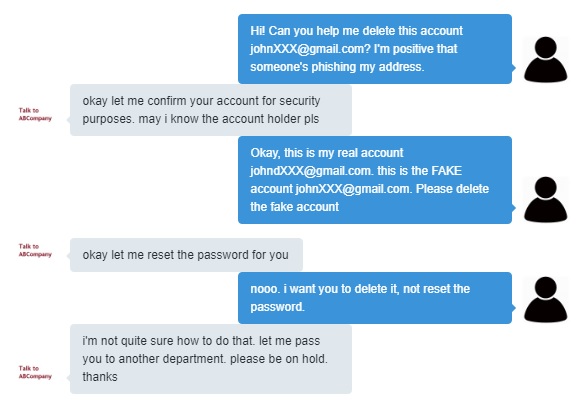
Solution: The best prevention to this is dealing with it early in the process. Make sure that you hire a reputable outsourced tech support team that are trained in their field. Also, encourage your support team to regularly exercise their knowledge about your brand, services, and products. Enlighten them about their responsibilities as well as the functions of other departments. So, if they encounter an inquiry beyond their capacity, they know who to coordinate with.
Lack of empathy
Empathy is a soft skill that is difficult to teach. When a customer reaches out to you asking for help after some kind of tragedy struck them, the least you want to do is stress them even more.
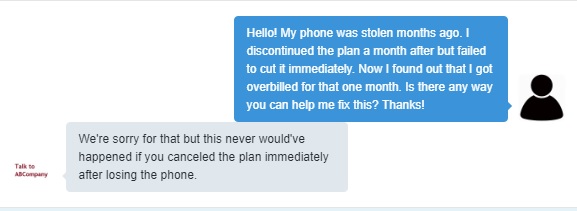
Solution: You want to treat your customers with compassion. For cases such as this, you may offer to review suspicious activities from their account and provide them with the best help you can.
Asking the customer to switch channels
You may have different channels where customers can contact you. But if one decided to reach out via your website’s live chat, and you ask them to send an email instead, then you’re on the running for bad customer service.

Solution: If a customer reaches out via phone or however method they choose, respect that decision. It’s their personal preference. If the issue can be resolved through that channel, then walk them through it via that same platform.
Irrelevant upselling attempts
Customers get turned off at the sight and sound of inappropriate attempts at selling them other products or services.

Solution: They already contacted you due to service interest or request, which means your brand already got their attention. You obtained a new customer! So answer their inquiry directly. Is your monthly subscription plan a fixed price? Yes, or no?
Making the customer feel stupid
You should never make your customer feel stupid or at fault. That’s a recipe for disaster.
In such cases where the customer is at fault or simply not looking hard enough to find solutions to their problems, go for an empathic and friendly approach.

Solution: Instead of going the passive route like the example above, try resolving the issue at hand like this:
“Hi, [customer’s name]!
Thanks for raising this to our attention. The new interface got me confused, too, at first, so no worries! On the upside, I’ve found the way around it by [explain the solution].
I hope this helps! Don’t hesitate to reach out for further questions.
Cheers,
Angel – Support Rep”
Wrapping Up
Not all customers are created equal. Which makes excellent customer support a vital facet of your company. It’s the one aspect that reaches out to your customers; it’s the voice of your brand.
Outsourced technical support not only helps your business cut back on IT costs but also saves you valuable time while improving customer experience. You can focus all your attention on growing your company, and your tech experts will handle streamlining your operations and keeping your customers satisfied. That’s what having a great tech support team is all about!
Learn more about the future of technical support outsourcing or send us an inquiry today!
The Pros and Cons of Building Bespoke Software
A streamlined operation is a part of what helps businesses achieve their goals. Having an organized process means knowing you have the tools needed to meet operational objectives as a company—and this includes business software solutions.

Generally speaking, organizations need specialized software that fulfills their business needs. Developers understand these prerequisites and have the tools and skills needed to create the programs. Business software solutions are developed and used for completing complex business tasks and reporting activities in an automated manner.
Aside from streamlining processes, business software has other benefits to companies—it offers better productivity and improved control, lessens the risk of human errors, allows for effectiveness, consistency, and accuracy, and performs tasks in a shorter period to help reduce workload. Some of the standard business software solutions include the following:
- Word Processors: comes with spelling and grammar checker for error-free letters and reports.
- Email and Communication Programs: helps in information exchange within and outside the company.
- Recordkeeping Programs: comes with accounting or bookkeeping features for tracking sales and expenses.
- Human Resource Information System: handles HR roles like employee management, recruitment, employee record maintenance, training, and payroll.
With advancements in IT not showing signs of slowing down, new software solutions that can support business operations are being introduced daily. You have the option to either build the software with help from your developers or buy ready-made ones. But, how do you know which solution best fits your business’ needs?
Custom vs. Off-The-Shelf
A custom or bespoke software is a program that is made-to-order to aid the specific needs of a single company, while Off-the-Shelf software is commercially available to the general public. Custom solutions are made to cater your business’ unique requirements, but ready-made programs will require your business to adapt to its features.
Commercial software can also be packaged, wherein programs are grouped to provide different tools that are under the same family in one software. The applications share a few similar features but make a complete package for the user. The best example would have to be Microsoft Office and the tools under it, including Word, Excel, PowerPoint, and many others.
Since off-the-shelf software is made for the public, it is generally created to be user-friendly. The interface for bespoke, meanwhile, can be complicated since it’s customized for the professional who will use it. As for the price, commercial software is generally cheaper compared to custom since bespoke software is made exclusively for one company.
However, this price difference also entails risk. Commercial solutions may be more inexpensive but may not always have what you demand. You’re assured that a tailored option will fit your needs, but since it means working through custom software development, you would have to cover all the expenses involved in the process. In this case, you may risk paying the high prices but not get what you want in the end.
Bespoke Software: The Good and the Bad
Based on these differences, it may seem like bespoke software has a lot more advantages for businesses with unique challenges; but benefits sometimes come with disadvantages, as well. Before you decide on a customized solution for your business, consider the pros and cons of building your own software as opposed to purchasing commercial ones first.
Pros
Your Own Solution
Custom software is made for your business’ needs and is meant to be the solution to all of your organization’s problems. Therefore, it is unique to you, and you own the software (though you may have to check your agreement first if you tapped a third-party developer to do it for you). There’s no denying the value of product that purely exists for your company’s best interests.
Flexible Support and Updates
If needed, you can easily modify and expand your custom software to keep up with the changes in your business and with technology. You can also choose to update and improve your solutions at your own convenience. With custom software, your company can define the scope of features, the level of support, and overall design to fit your needs specifically.
No Security Issues
Commercial software can be quite risky. Since you’re sharing software with other users, your company may be in danger in case of a hack. For custom software, you can only be in jeopardy if the hacking is targeted to your software or company. Even then, developers can enhance security by integrating it with another security solution that they have.
Competitive Edge
Since the software is only made for you, your competitors won’t be able to use the same software, and you don’t have to share it with them. This gives you a competitive advantage that can’t be easily replicated.
Cons
Takes Time and Energy
Bespoke software is not a quick fix. The development phase, from understanding your business needs to discovering bugs before the actual launch, can take several months. Depending on the nature of your business—and while the process will eventually deliver a great solution—time may be of the essence and undergoing development hell may not be the best idea for you.
High Upfront Cost
As mentioned, developing custom solutions from scratch is not going to be cheap. However, the substantial upfront investment can result in robust solutions that can reward you with an even better amount of gains in the future.
Features May Be Limited
Readily-made solutions often cover a wide range of features, which can be convenient at specific instances. Bespoke ones won’t start as feature-rich; it may take some time to gradually make improvements along the way.
Dependent On Software Provider
Custom solutions need to be regularly updated and checked, which means you’d have to be reliant on your provider to maintain it. However, this can be easily remedied by choosing the right developer or company; one that you already have a good relationship with and are experts in the field.
Conclusion
Custom software development services are flourishing more than ever because businesses realize that they can use them to implement their unique ideas and USPs. It’s also ideal for those who want to get the most out of what technology has to offer, as long as you’ve got the time and resources to spend on development.
Some may even go the hybrid route: buy off-the-shelf solutions but also put in custom applications that can be integrated with commercial ones. This way, they can get both the fundamental features of off-the-shelf products and the unique services of customized solutions.
In the end, the best solution will depend on your business’s nature, needs, and budget. Choose the solution that will answer your challenges and organize your processes without going over your allocation.
Looking to build a custom software for your brand? Contact Intelligent Bee today to find out what we can do to grow and support your business!
The World Needs More Software Developers!
The rise of technology and digital tools in today’s modern world is evident. Everywhere you turn, you can see a student working on their laptop in a coffee shop or a kid playing games on their parent’s smartphone. The widespread use of smart devices is set to expand in the coming years, until one day, no one will be able to recall what life was like before phones and other gadgets.
Because of this, the demand for technical professionals has naturally increased. In fact, the role of software developer is the reigning “best job” in the U.S., according to data from the U.S. Bureau of Labor Statistics. Said survey identified jobs with the highest hiring demand, best work-life balance, and most competitive pay, among others.

Programmers aren’t just relevant in software development companies or industries that are “obviously” tech. Demand is growing in practically any industry that needs talented individuals to create digital applications. With the digital transformation many institutions are undergoing today, this growth in demand applies to the health sector, financial service industry, and education, to name a few.
What does this say about the future of software development and the increasing involvement of tech in various industries?
The Growth of Software Demand
More and more companies are on the hunt for software developers, but there aren’t enough people to fill the role. In the U.S. alone, there are over 200,000 open jobs for this role, and yet data shows that there are only around 30,000 computer science majors who graduate every year.
Following this trend, there will always be a shortage of software developers in the industry. It could take almost seven years to fill the current open roles. That’s not even accounting for the future projection that there will be about a million computer programming jobs expected to open by 2020.
Companies are understandably frustrated with this situation, but they still try to address the shortage in other ways. They are hard at work to make employees interested and excited about additional knowledge in programming, creating an emphasis on teamwork rather than technical know-how.
This means building opportunities in training workshops on coding, programming, and software development to current employees who might be interested in the field.
Homegrown talent is also a major trend in addressing the lack of qualified software developers.
Bloomberg featured the strategy of two businesses, JDA Software Inc. and Social Tables, who both have programming internship programs. A senior engineer is paired up with a rookie, and from there, the company will decide if a candidate will get absorbed or not.
While these techniques work for some businesses, not every organization is so lucky. There may be a lack of general interest in programming or too little resources to implement a training program, which points back to the need for software developers.
Quality Developers are Still Few and Far Between
Just as with any position, having people interested in the job is not enough for them to get hired. There may be existing programmers on the market, but their inexperience may throw off companies who want to hire someone with better skills.
Therefore, it’s not just the question of having a shallow talent pool to begin with, but also the skill level of those who do want to apply. Lack of experience is one of five hiring challenges for software developers, including lack of technical skills, high salary demands, lack of workplace competencies, and lack of formal engineering education.
Besides this, there is also a great struggle retaining talent in the software development industry.
Because of budget restrictions, start-ups have no choice but to hire entry-level programmers, whose skillsets may not quite cover all of the company’s needs. As the company grows, they will be able to afford mid and senior level developers who will inevitably spot the errors of their predecessors and fix it.This issue can get repetitive and tiresome for programmers. Instead of creating something new, they get trapped in an endless cat-and-mouse chase with errors and poor coding.
In effect, some developers willingly exit the industry after over-fatigue from repetitive work. It’s a difficult situation to escape from, seeing as the scenario above can turn into a vicious cycle.
Final Words
Here’s food for thought: How can software developers take your business to the next level? Just imagine all the possibilities.
Technology will continue to evolve at a much faster pace than most humans will understand. Even if there are enough software developers in the world, the opportunities that new tech will bring are infinite. There will always be something new to learn, and that’s an exciting thing!
In practically any industry you put them, software developers can help make the businesses more effective. There’s a high demand for them, and this will only grow in the coming years. Supporting educational programs and opening up training for people who are interested are good ways to contribute to the reproduction of software developers worldwide.
Are you a prolific software developer? We want to hear from you. Visit our careers page today!
The Future Of Technical Support Outsourcing: Top Trends And Things To Know
2018 is coming to a close, and most people live, breathe, and eat the Internet. It has empowered consumers to perform a lot of tasks that previously took a lot of time to do, such as shopping, learning, banking, and more. The world has become a smaller place because of this, as the internet allows people all over the world to meet at a common place: online.

To keep up with the needs of the people, businesses have also migrated to this space. Naturally, each company aims to provide the best products and solutions for consumers globally.
In an ideal world, business operations go smoothly and customers never have any problems or issues at all. Sadly, we’re not living in that world. If your website, e-commerce store, customer support system, or any other online channels break down, various aspects of your business could be compromised. It could even create a negative impression with your consumers or hurt your sales.
So, in a world connected by the internet, social media, and smart devices, it’s in almost every business’ best interest to invest in technical support outsourcing. It’s more than just the digital version of calling a plumber to fix your leaking pipes.
Tech Support Outsourcing at a Glance
Companies need tech support for a variety of reasons, and the core focus of the support will depend on what their priorities are and the industry that they operate in. Here are some of the most commonly outsourced tech support functions and how they add value to a company:
Data security – Secure data servers are essential for the business as well as their consumers. For one, company data may contain business plans, financial plans, and any or all tactics that companies use to grow. This is top secret information that should not fall into other people’s hands. On the other side, there’s sensitive information that customers entrust businesses with (credit card details, residential address, etc.) that should also be protected at all times.
Automation – Processes run faster and more efficiently when things are automated—whether it’s payroll, marketing, or inventory management, analyzing and improving the processes that can cut down operation times is crucial.
Customer service – In the age where the customer is king, it’s absolutely essential to add value to the customer experience wherever possible to stand out from the competition. Customer service and support play a huge role in defining the overall customer experience quality. And although it might not directly affect business growth, it more than makes up for it by fostering trust, loyalty, and advocacy.
Software Application Development/Maintenance – The digital age has brought about an increased number of software projects, which can be costly to develop in-house. Outsourcing app development and maintenance helps reduce overhead costs associated with software implementation and provides the necessary technical expertise to provide high service quality.
Cloud services – The usage of cloud services has been commonly associated with Software as a Service (SaaS) and Platform as a Service (PaaS) businesses. This involves applications that are hosted by the vendor and made available to customers through a network (the internet). This approach lets businesses create and implement applications without needing to invest in the underlying infrastructure, reducing costs and increasing overall efficiency.
The Future of Technical Support Outsourcing

Technical Support Outsourcing Market Growth
Earlier this year, it was revealed that the technical support outsourcing marketing is growing steadily. It is set to achieve a CAGR of 8% by 2022, denoting that the industry is about to expand due to new technologies and higher demand from businesses.
Chatbots and Virtual Assistants
IBM reports that 85% of all customer interactions will be handled without human agents by 2020. Customer-centric business practices are here to stay, and chatbots help businesses achieve this. By always being there for the consumer, their questions are quickly addressed in a fast and timely manner.
This opens up new opportunities for the tech outsourcing scene by creating new roles and functions within the industry. IT experts will now have to work with the latest technology like AR, VR, IoT, and the like.
Cloud Services
Cloud services are not just limited to enterprises anymore. Small-to-medium businesses are set to migrate to cloud computing to optimize their business process, increase productivity, and reduce hardware costs. It is projected that cloud traffic will increase 3.7 times by 2020.
This is easily becoming one of the top reasons why companies outsource IT support. It’s efficient, cost-effective, and these days, they’re a business staple.
Emerging Markets
IT services are commonly outsourced in India, Malaysia, and the Philippines. In the coming years, this is set to change. Studies suggest that new markets in Vietnam, Colombia, and the Czech Republic will compete with existing markets in offering the best and affordable tech support. This signals that demand is rising, and the tech support outsourcing industry is growing.
Augmented Reality
The adoption of AR can change the tech support industry as a whole by allowing remote teams to help each other more effectively. A great example is Porsche’s AR program Tech Live Look, which allows their tech experts in Atlanta to help on-site mechanics solve issues in various dealerships. They were able to cut down service time by almost half and communicate with other team members more seamlessly while in different locations.
Predictive Analytics
Data has gotten smarter with predictive analytics. Benchmarking and calculating performance improvements will become more manageable as new tech can now analyze past metrics, customer behavior, and service outcomes. This will allow businesses to focus on their ops and keep all teams aligned with their goals.
Rising Demand for Cost-Effective Solutions
Having onsite technicians can burn a hole in a company’s wallet. Outsourcing has long been proven to help lessen that cost, and still allow businesses to provide high-quality support internally and to their loyal customers. The rising demand for this service creates a bigger market share for the tech support outsourcing industry.
Network Security
A 2017 Enterprise IT Services Survey notes that networking security is the number one priority of digital businesses. Almost half (47%) of the enterprises surveyed mentioned they outsource data security more often than any other IT service.
With the recent data breaches from major digital companies (i.e., Facebook and Google) enterprises are now compelled to focus on corporate and customer data. IT outsourcing contracts will include specific clauses to prevent data breaches and manipulation.
Customer-centric Servicing
Automated customer service is not limited to time zones or public holidays. This allows companies to deliver round-the-clock customer service and resolve issues at a faster rate. In effect, this can increase brand loyalty.
Online Reputation Management
Companies, whether digital or not, all have an online presence. They quickly realize how pertinent having social reputation management is to their name, whether they tap social media, online PR, or SEO services from their outsourcing partner.
AI and Robotic Process Automation (RBA)
RBA will continue to lower the cost of outsourced tech support services. Companies will prefer vendors that can provide this versus those that can’t. This makes use of AI workers and robots to automate common and repetitive software development tasks for increased process efficiency and cost-savings.
Adopting Emerging Technologies
With the rise of the Internet of Things (IoT), blockchain, and machine learning, among others, tech systems face a lot of advancements and updates at a much faster pace. Outsourced tech support agents are usually the best people companies can approach, as they are always updated with the latest tech buzz and innovative software.
Customer Identity and Access Management
CIAM software can provide a seamless cross-channel customer experience. It’s a rich database containing all information about your buyers. With this, both IT teams and managers identify the best way to market to customers. Yet another function businesses are looking to outsource.
Closer Relationships with Managed Service Providers (MSP)
The search is on for professional and loyal IT teams. Managers are now keen on the idea of having Managed Service Providers as consultants and business partners, further illustrating the importance of tech support for organizations.
Complete Integration from Managed Service Providers (MSP)
Companies prefer to have one MSP providing all their outsourced IT functions. In line with making MSPs business partners, this will allow for seamless integration, so that all business functions can work together in sync.
Final Thoughts
Thanks to our increasingly tech-filled world, IT services aren’t going out of style anytime soon. Effectively managed tech support and services can pose a lot of benefits for your business, from increased manpower and lowered costs to higher customer satisfaction and retention rates.
With the rising demand and advancing technology, the tech support sector is definitely poised to continue growing rapidly over the next few years. It’ll be interesting to see what other developments come next!
Contact us today to learn more about what the future of technical support outsourcing means for your business!
Will bots really replace the human customer support role
Perhaps it took longer than expected, but the rise of the machines is now at hand. Artificial intelligence is fast becoming more advanced and is now being used in a host of applications. It’s changing the technological landscape as we know it, bringing us closer to Cyberdyne System’s Skynet computer.
But let’s not get ahead of ourselves, folks. We’re currently working on and perfecting AI functions that can help us humans do simple, labor-intensive ‘narrow’ tasks across different industries. A neural network controlled by a sentient AI computer is still far from reality, but with the way things are going, it’s not impossible.

The progress we’ve been making in the field of artificial intelligence has been no less impressive. Machines can now perform predictive analysis, deductive reasoning and natural language understanding, which are all needed in understanding and predicting what the user needs or maybe offer recommendations for the next action.
Now that we’re taking the development of AI in the right direction, it is found to have good use in the field of customer service. Chatbots are now all the rage in the tech world, simulating conversations with people to address their questions or perform simple tasks. These bots are now booming not only in text conversations but in verbal exchanges as well. Yes, we’re looking at you, Alexa.
AI’s Role in Customer Support
Businesses need a fast and efficient customer support service to address all their customers’ concerns. This helps them forge good relationships, making it an essential factor in running a successful business. And with chatbots now taking the place of humans in online conversations, they are revolutionizing the customer service industry.
Chatbots automate conversations with real humans by delivering the right responses according to how they are programmed to do so. With language processing now an integral part of AI, conversations are more seamless, as if you’re having one with a real human being. Advancements are set to further make it harder to discern if you’re chatting with a person or perhaps Threepio.
Many companies embrace a chatbot’s functions as a means to complement or even reduce the need for call centers. As human-to-human chat conversations become a thing of the past, this will significantly reduce operating costs.
For now, chatbots are used to collect basic information, with the more advanced versions providing resolutions for increasingly more complex issues. This speeds up response times and frees agents for more challenging work that requires a more advanced brain. Yes, the one responsible for creating chatbots in the first place.
Why Bots are Here to Stay
The bots we’ve read about or seen in fiction were made to serve humans, and their purpose hasn’t changed one bit in real life. Now that AI-driven chatbots are being extensively used in the field of customer support to perform repetitive and simple tasks, they are proving to be invaluable.
Despite being relatively basic, bots can help relieve humans of the grunt work, which can streamline any process and make things move along faster and a bit easier. This saves loads of time and money for the company during the technical support process. Here’s how it works:
Process Efficiency
When calls come in, human agents go through the motions of collecting information from the concerned customer before they proceed to address the issue. AI-driven bots can streamline this step and cut the time it takes to complete this task, so a human agent can resolve the issue at hand. Although support ticket qualification is a fairly simple task, automating it can result in huge time savings.
Cost Efficiency
When processing time is lessened to a considerable degree, more calls can be processed within the day. This significantly decreases the operational cost by taking in more customers who need help in a single day. When AI becomes more advanced, pretty soon there will be more stages in the operation that can be taken over by bots. This will allow humans to focus on more difficult tasks and become even more cost-efficient.
Better Customer Experience
Once the process is streamlined to a point where your service addresses all customer concerns in a reasonable period of time, you will leave them feeling satisfied with the whole interaction. The bots help make the process faster, and the human touch becomes more focused on a customer’s needs. All this leads to a better customer experience, creating a competitive advantage for your brand.
Timeliness
Machines are all about speed and precision. They help cut work time to achieve results faster, which is the reason why AI-driven bots are increasingly becoming popular. Additionally, the risk of human error is basically non-existent. So, when it comes to menial tasks, bots are faster and more accurate – it really isn’t much of a competition.
But Will They Replace Humans?
With AI being able to handle increasingly sophisticated tasks, many believe they’re a growing threat to us humans. People are under the impression that they will start taking jobs away from us, and before we know it, they will gain sentience and start making slaves out of us ‘fleshies.’ That is one dystopian future nobody wants to become a reality.
But before we get in over our heads, AI-driven machines aren’t about to take us out. We are still at a stage where we are finding ways to make machines help make our jobs easier. And regardless of how far we’ve made them more advanced, there will always be a need for a human touch.
Humans take a lot of things into consideration when making an important decision. There are intangibles involved, such as emotions and creativity, which they combine with logic to arrive at the best outcome from any situation. On the other hand, bots based theirs purely on data and may be limited in scope.
Final Note
The advancements happening in AI technology are something to look forward to, but for some, they could be a threat. Even tech magnate Elon Mask has expressed concerns about AI warning us that it may create an ‘immortal dictator that we can’t escape from'.
But fret not! There won’t be any T-1000s hunting us down anytime soon. The whole point of AI-driven machines is to help us humans from labor-intensive tasks that can shorten the process. This makes the combined efforts of AI and humans more effective, with humans still overseeing that everything is going the way as planned.
Your job is safe. For now at least…
Looking for help with your technical support initiatives? At Intelligent Bee, we've got a team of experts (with the human touch) ready to provide flexible solutions at competitive prices. Contact us today!
Are You Ready to Build Your First Corporate Mobile App?
If you haven’t noticed, there’s now an app for almost anything. It used to be that apps were associated more with mobile games, but thanks to mobile app development technologies, that’s no longer entirely the case.

Today, there are non-gaming mobile apps that enable people to get things done or get the product or service they need straight from their smartphones. For instance, people no longer need to leave their house if they want to do their groceries. Through e-commerce apps, shoppers can buy household items and then have these delivered at their doorstep – all accomplishable with a few simple taps.
The following data shows that corporate mobile apps are noticeably proliferating across industries:
- As of 2018, the number of apps available to consumers on the leading app store (Android) has already reached 3.8 million. (Statista)
- The increase in mobile app usage outside of the gaming industry is as follows: 332% for device customization slash enhancement apps; 135% for mobile newspapers and magazines; 125% for productivity apps; 81% for lifestyle and shopping apps; and 53%-54% for travel, sport, health and fitness, messaging, and social apps. (Smashing Magazine)
- Revenue from in-app purchases – which enable the app to earn money each time users purchase something within the app – amounted to $37 billion in 2016. (BusinessofApps)
- Companies like Domino’s Pizza and Zara increased their sales by 28% and 60%, respectively, with the use of their mobile app. (KnowTechie)
Keep in mind that these figures are expected to continue growing as the mobile age reaches its maturity. If that’s not enough to convince you of the value that mobile apps bring to the table, why don’t we take a look at some of the most compelling benefits they can help you realize.
The Benefits of Having a Corporate Mobile App
Brand awareness
A mobile app puts your brand in front of consumers and increases their recognition of your business, especially if you take functionality and user-friendliness seriously. Over time, as users try out your app, they’ll become more familiar with your brand, business model, and line-up of products and services. This builds up a level of trust, which makes people more likely to choose you over other businesses, which they have not encountered before.
Customer engagement
Mobile devices are so handy that people have been spending a great deal of time on them, specifically on smartphone apps, which represent about 90% of users’ mobile time. With the right app, you can reach more users online and engage them every step of the way.
Thus, it’s important that you build several features into your app, including those that customers need for placing orders, managing purchases, keeping track of promotions, and communicating with customer service, among others.
Marketing directly to customers
One of the biggest advantages of having a mobile app is it gives you an opportunity to market your business directly to customers. Think about it. A corporate mobile app is like having a whole new marketing channel.
Each time users open your app, you can send them information about new or upcoming products that you think they might be interested in. Moreover, you can use your app to capture important customer data, such as their product views or order history, and then use it to improve their experience within the app.
Added source of revenue
A mobile app can be an income-generating tool for your business. Having an enterprise mobile app not only complements your brick-and-mortar sales but also lets you monetize people’s use of your app in a couple other ways.
For instance, you can bring third-party advertisers into your app and charge them whenever someone clicks on their ad. Another monetization model for your app is to charge users a monthly subscription fee, so they can continue using the full features of your app.
Complementing your website
You might think you no longer need a mobile app if your website is up and running anyway. However, you can design your mobile app in a way that supports your website, so you can serve customers in a more optimized fashion.
Since users who have no internet connection will not be able to access your website through a browser, they can have your app installed on their mobile devices, so they may still enjoy certain functionalities through offline mode. That said, you can build an app that allows users to save the information or files they need for offline viewing or reading.
Questions to Ask Before Venturing into Corporate Mobile Apps
Before springing into action, it helps to know the ins and outs of mobile app development. Here are some questions to ask yourself before proceeding with your project:
- How much will it cost? The cost of building an app depends on several factors, including the type, size, and functionalities of your app, to mention a few. Your app’s overall goal will tie into your budget to determine what to build and how much to spend on it.
- Which platforms will the app support? Your two main markets are iOS and Android devices, but you should also take into consideration that there are Windows phone users.
- What’s your goal? In developing your app, you should also identify how it’s going to help your other business goals. Revenue wise, you can choose whether you will charge for in-app purchases, app downloads, or third-party ads. In terms of customer experience, you could prioritize between functionality and a pleasing user interface.
- Do we have the skills? You’ll need tech wizards to visualize, design, develop, test, and maintain your mobile app. If your team doesn’t have these specialized skill sets, you can outsource your mobile app project to a software development company instead.
- Is there a need being fulfilled? You’ll want a winning app that fulfills an unmet need in your target market. Your app should fill the gap between what users want and what options are available to them so far.
- How to market the app? To get your mobile app into the hands of users, you’ll need to promote it on multiple channels, such as blogs, social media, email platforms, app stores, PR events, paid advertising media, and the like.
- What integrations will you build into the app? You can leverage your app by into it, or by allowing users to log into your app using their social media credentials. This will make it easy for users to share information from your app to social sites in a seamless manner.
Conclusion
To maximize your corporate mobile app’s chance for success, you should be able to answer these questions. Now, the million dollar question is: Are you ready to build your first corporate mobile app?
It will all boil down to how useful your app is for both your business and your customers. Make your app great enough that customers would want to install and keep it in their device for as long as possible.
Want an experienced team of developers to build your next corporate mobile app? Contact the experts at Intelligent Bee today!
When Should Businesses Outsource Custom Software Development?
Most, if not all companies have a common goal – and that’s to be the best in their field. As industries are becoming more globally competitive, it’s crucial that you continuously evaluate and improve the way you do things to avoid being left behind. It’s also critical that you make the right business decisions, such as when or why you should outsource your company’s digital application or software development needs.

Here are different scenarios where you might need to tap the services of an external custom software development team for your business:
When you’re trying to focus on core business areas
IT work takes up time, which might prevent you from concentrating on core business activities that drive revenue. If you see that building your IT projects takes time away from your main business, you might be working on your priorities all wrong.
When you free yourself from IT-related tasks, you can focus your assets and resources more appropriately on your company’s area of expertise. This can help you establish leadership in your industry since you’ll have more time to innovate your current offerings, resulting in better customer satisfaction along the way.
When you lack the budget
A low budget for your IT department can be a significant challenge, mainly because developing software is costly. You’ll have to pay upfront costs to build your IT infrastructure, purchase development tools and licenses, and hire and train IT staff. These costs can further increase as your team grows.
By contrast, there aren’t many overhead costs involved when you decide to outsource custom software development to third-party contractors. Often, these vendors offer full-cycle development services in custom software, mobile application, and web application development at cost-effective rates.
When you’re short on expert developers
Software development has a very technical nature to it, which makes it mandatory that you hire only the most experienced developers. If you don’t have access to highly skilled developers, you should definitely consider outsourcing a team.
Expert developers have more experience in this field and will be able to better design software that suits the specific needs of your business. As they work on your project, they can anticipate possible problem areas and immediately make helpful recommendations.
Hiring developers with complete skill sets can lead to many positive things once the software goes live, including optimum efficiency and usability levels, better security, and ultimately, a high return on investment (ROI).
When you don’t have the infrastructure
You’ll need to invest in a formal tech infrastructure for software development. However, if your business model isn’t directly related to this discipline, it might be unwise to build an IT infrastructure from scratch in-house.
In their years of being in the business, outsourcing companies have already established a robust IT infrastructure. They have state-of-the-art technologies and solutions to address even the most complex projects. Your business will also benefit from a fully functional IT infrastructure, so the security of your customer data and other company resources will not be compromised.
When you lack support and maintenance manpower
Software design or development is not a one-time project. You’ll need to continually monitor and modify how it works, depending on the needs, demands, or expectations from end-users.
If your company doesn’t have a dedicated team of tech support, your product could quickly become problematic. An outsourced team will be responsible for introducing new features and fixing system bugs to make sure that the product works as efficiently as possible. This way, you don’t have to replace or rework the software altogether every time an issue shows up.
When you have limited access to cutting-edge technology
When it comes to technology, things are always moving in the fast lane. What’s new today may not be so unique tomorrow, with developers constantly coming up with and releasing more advanced programs. To help your company adapt to rapid technological shifts, you can look to outsourcing companies since they have ready-access to the latest technologies, tools, and resources relevant to software development.
When product movement is quite slow
Tech guys agree that dev work is a step-by-step process, where shortcuts are not always possible. Then again, there’s the business perspective that the sooner you can get your product out there, the better.
To prevent your company from having to deal with this dilemma, you’ll need to exert more control over how long your software development takes to finish. Software development companies recognize this need and are reliable enough to deliver what’s expected of them within a reasonable timeline.
When your quality assurance processes are insufficient
Outsourcing companies take pride not only in their technical expertise but also on their knowledge about market trends, which allows them to deliver high-quality work to clients. With their technical skills, they can help you improve your products to deliver an enhanced experience to both your employees and end-users.
You can ask for as many product testing and trial sessions as needed before finally rolling out your software to the public.
Final Words
Your custom software development needs to be precise, organized, and timely to have the competitive advantage that you’re aiming for. Since many aspects in software development require specialized skills, you’ll want to work with the best team you can find.
Intelligent Bee’s track record in providing custom software development services is like no other, as we offer software solutions that suit your business needs and resources. Contact us to start your project today!
Technical Support Scams To Watch Out For (And How To Spot Them)
Technology has helped the world in many ways, but there’s no denying that there’s a dark side to it. For instance, phones, computers, and the internet can be exploited by fraudsters to deceive unsuspecting users into giving up personal information, and to some extent, their properties too.

Technical support scams do just that—they fool the unaware into thinking that there’s something wrong with their system and equipment, make them contact an unknown number, and steal personal information as victims are unknowingly being tricked. There are also instances wherein the scammers are the ones who call the user.
Tech Support Scams in Numbers
These types of cons are nothing new, but admittedly a lot of people still fall for it, especially since criminals keep finding new ways to conduct their fraudulent activities. A 2016 survey sponsored by Microsoft found that 2 in 3 people have experienced a type of tech support scam within the past 12 months; 1 in 10 have lost money.
In 2017, Microsoft’s Customer Support Services received 153,000 reports of such scams from 183 countries, with a 24% rise from the previous year. Approximately 15% of those who reported lost an average of $200 and $400.
Virtually anyone who owns a connected device is vulnerable—even though Microsoft is often namedropped by tech support scammers (with the company receiving 12,000 complaints every month globally), having a device other than Windows cannot protect a person either, as these deceptive acts can also fool those who use MacOS, iOS, Android, and other operating systems.
In terms of age, scams reported to Microsoft tend to be from older customers. The US Federal Trade Commission (FTC) has found evidence that the elderly are more impacted by fraud as compared to the younger generations. However, it was also found that millennials (ages 18–34) are more likely to continue with a fraudulent tech offer compared to other age groups.
The underlying cause, though, is that many people are fooled into thinking that they are working with a legitimate business, whether that user is old or not.
The Fallout
As mentioned, tech support scams are designed to trick users into believing that their devices are compromised. The frauds will then coerce the user into purchasing unnecessary support services. In some instances, they will request access to the user’s device by getting sensitive information or making them install dubious apps that can remotely retrieve the details they need.
In December 2014, when tech support scams hit mainstream media, Microsoft sued several companies for unfair and deceptive business practices and trademark infringement. Later in 2015, the FTC announced the shutdown of several tech support scammers that pretended to be associated with Apple, Microsoft, and Google, and stole a combined $17 million from consumers.
In another case, the FTC had to give out partial refunds to around 37,000 victims of a fraudulent tech support company named Inbound Call Experts. This is after the company tricked consumers into buying unnecessary products and services by pretending that there is something wrong with their computers, all of which happened from April 2012 to November 2014.
No matter how big a business is, taking a legal action remains to be an arduous process. In this instance, Microsoft had to deal with the consequence of additional costs to fix issues that the company didn’t intend to put themselves into.
Despite Microsoft proving their innocence, there’s no denying that negative news like fraud can have a lasting impact on consumers. Those who don’t know better would likely continue to associate Microsoft with the fraudsters.
Spotting the Sham
The best way to avoid falling into shady acts is knowing what constitutes a tech support scam.
Unsolicited Calls
This outdated yet effective sham is done through cold calls. The fraudster who claims to be from a reputable company will call the target and say that the company found something wrong on the computer.
Microsoft and other companies often employ outsourced tech support, but no tech company will ever reach out to the consumer, even if it’s in the name of public service. Microsoft’s security bulletin reads, "Microsoft will never proactively reach out to you to provide unsolicited PC or technical support. Any communication we have with you must be initiated by you." That means users will only receive a call if they request it.
In addition, caller IDs can be manipulated to show only the company name, but not the number, so it’s not reliable either. Hang up if this ever happens, and never give any personal information.
Phishing Emails
It’s easy to fall for a phishing email because it does look like a message from a legitimate source. But once the target clicks and visits a malicious link included for a fake site that the scammers control, they will then be fooled into filling out a form with their sensitive information like email password, credit card details, bank account number, etc.
Again, the best way to avoid this practice is to ignore it (and delete the email, too) and never reply. Don't click any of the links on it, either. Remember to change passwords regularly as well.
Sketchy Advertising or Pop-ups
Pop-ups appear when users are browsing the Internet and visit a website that contains suspicious links that, when clicked, will redirect them to a site hosting the pop-ups. These pop-ups can get so intrusive that it can become difficult for the user to close them as they appear.
Often, these pop-ups will contain a message stating that the computer is infected or that it will be locked down, blocking internet access, or making it unusable. The message will usually be accompanied by a phone number which the user can contact to fix the problems, or so it claims.
First off, you should know that legitimate IT support groups will not use pop-up messages to alert you of issues, so it’s best to ignore these messages. Aside from that, scrutinize the message and look for poor spelling or grammar and lousy imagery, which would usually imply fraud. A quick Google search can also support the legitimacy of the contact details included.
Confusing Search Results
Interestingly enough, fraudulent companies also have budgets to use legitimate paid search channels to advertise their fake support services. To be on the safe side, study the website chosen before retaining a company’s services and always keep an eye out for trust signals.
In Conclusion
As long as technology continues to advance, so will the swindlers who continue to take advantage of users, especially those who aren’t well-versed in the technological aspect. The responsibility remains with users and consumers, as they need to stay vigilant in this thriving yet perilous age of information security. Tech companies, meanwhile, should do their part and ensure better protection for their clients.









